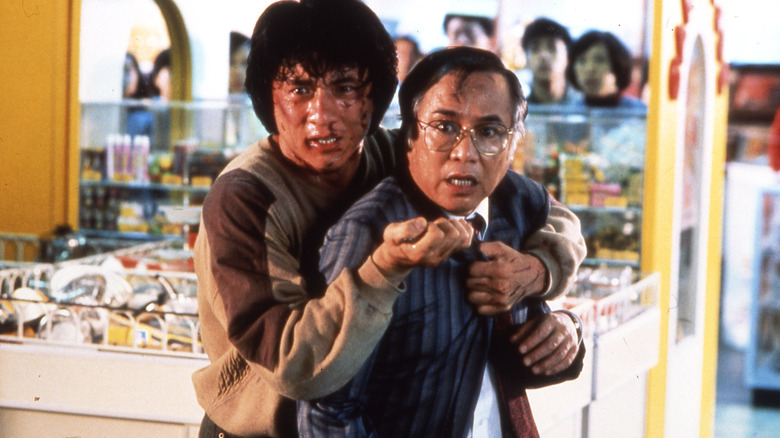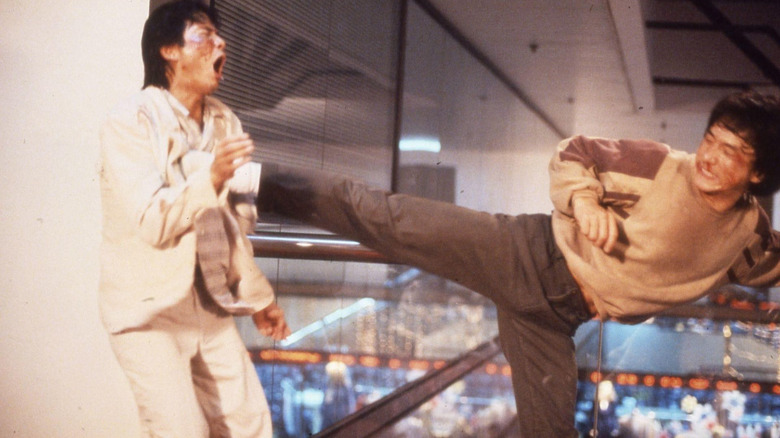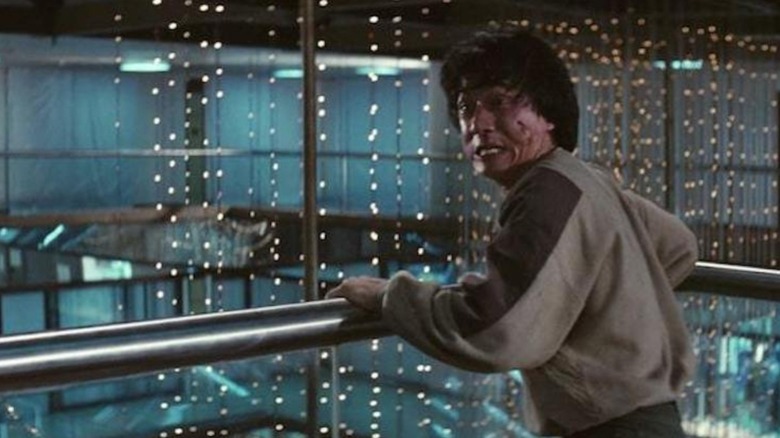The Mall Sequence In Jackie Chan's Police Story Is The Best Action Scene Ever
(Welcome to Best Action Scene Ever, a column dedicated to breaking down the best, most effective action sequences throughout the genre. In this edition, we circle back to Jackie Chan's stunt-acular action classic, "Police Story.")
Before Jackie Chan ever crossed the shores of the American mainstream during his Hollywood heyday in the 1990s, the actor/director/stuntman extraordinaire had been hard at work in Hong Kong cinema, churning out hit after hit for decades in his native country. One of his most memorable successes came only a scant handful of years before he finally crossed over into global appeal: 1985's "Police Story," directed by and starring Chan as Chan Ka-Kui, followed the rogue cop on his relentless quest to take down a drug lord, babysit a key witness played by Maggie Cheung, and subsequently clear his own name after being framed by his powerful enemies
The movie — which, quite honestly, could've had several different scenes come up as a contender for this column — kicks off with a jaw-dropping raid on the villainous Chu Tao (Yuen Chor) that crescendos with multiple cars plowing through a small hillside town, ups the ante with a frightfully risky stunt involving a runaway bus, and even throws in some deceptively complex bits of slapstick humor and complex physical comedy for good measure. Yet with so much to choose from, this action/comedy somehow manages to top itself with its concluding set piece set at a shopping mall that features a little bit of everything executed on an improbably high level.
The scene
Throughout the film, Chan's tireless cop Ka-Kui has remained in dogged pursuit of the powerful gang leader Chu Tao, going to whatever lengths necessary to arrest him and, most importantly, prove his guilt. Hilariously enough, the path to achieving that goal ends up becoming less direct than the straightforward cop would prefer. The crime boss' secretary Salina Fong (Brigitte Lin) is rounded up in the opening raid and compelled to testify at Chu Tao's upcoming trial (we're not 100% sure the legal proceedings as depicted in the movie fully check out, even for one set in 1980s Hong Kong, but just go with it), making her a prime witness and a top target from her own former employer. Naturally, Ka-Kui is recruited to serve as her personal bodyguard for the next 24 hours, which hardly goes according to plan.
Having escaped from both the police and Chu Tao's criminal racket, Salina finally regains a sense of agency from both rival organizations and sets out to take control of her own fate ... by stealing her old boss' incriminating computer data right out from under him. It's never made clear exactly what she means to do with this information, whether blackmail Chu Tao or hand it over to the police to secure her own freedom. (Again, who's to say this evidence would actually be admissible in court, but that's not exactly the point here!) But this juicy setup provides the momentum to bring the story to a head, turning the unexpected location of a shopping mall into the place where all three competing parties intersect in spectacular fashion.
Thanks to Chan's direction, incredible fight choreography, and some brazen (reckless?) stunt coordinating, this scene has since become immortal.
Why it works
The ol' maxim of "Keep it simple, stupid" applies to many different aspects of life, not least of all screenwriting. Although action filmmaking in particular can get away with incredibly convoluted plots on occasion if placed in the right hands, this generally tends to be helpful advice for keeping action sequences clear, coherent, and engaging so that storytellers can focus on adding all sorts of elements to spice things up. The final set piece of "Police Story" follows this to a T, despite the considerable length of the final sequence. Clocking in at almost 15 minutes, the setup and subsequent fight at the mall carries viewers through to the ending credits. None of it would've worked if not for Chan and co-writer Edward Tang's insistence on establishing the basics of the action.
It helps that, despite her murky motivations, Salina's inciting action of stealing the data sets up a very easy-to-follow sequence of events. Ka-Kui needs the evidence and Salina (who's the only living witness who can clear his name) intact to put Chu Tao behind bars for good. Chu Tao simply can't afford to lose that data, forcing him to send in everything he's got against both of our heroes. And through it all, Ka-Kui increasingly wavers between doing his job as a police officer, doing the right thing by Salina, and losing what little control he has left — a spiral that began when he was first framed by Chu Tao and his men for the murder of a (secretly traitorous) chief inspector.
The simplicity of the story allowed Chan and his team to go overboard with the stunt work: smashing any visible pane of glass in sight, jumping over escalators, and — famously — Chan sliding multiple stories down a pole.
The key moment
Tone can be an impossibly fine line for any filmmaker to ride. Push too much in the direction of humor, and even the most death-defying stunts won't pack the punch they need in order to land with an audience. Pull back and go darker, and you risk creating an atmosphere where over-the-top action feels jarringly out of place.
"Police Story" tells its story with a noticeable amount of earnestness right from the opening scene, charting a deadly shootout between the police and Chu Tao's forces ... with a surprising amount of screen time dedicated to one police officer wracked by trauma and stress at the prospects of being in his first engagement. From there, however, Chan's Ka-Kui is depicted as an almost absentminded slacker: capable of earning commendations and promotions from his higher-ups with his bravery in the face of danger, but with no compunctions about staging a home invasion just to prove a petty point to Selina that she needs his protection. Throughout the film, Chan pokes fun at his own character (and, by extension, his rapidly ascending reputation as a movie star) as a chauvinistic pig, but manages to dial it back once the story takes a darker turn and Ka-Kui becomes much more desperate, compelled to take his own superior officer hostage to escape custody so he can prove his innocence.
The key moment comes in the movie's final seconds. Having thoroughly exhausted himself fighting off a small army of henchmen and barely managing to protect Salina, Ka-Kui survives long enough for the police to arrive and take Chu Tao into custody. But after his girlfriend May (an underused Maggie Cheung) is put into danger, our hero snaps and gives the villain the karmic beatdown he deserves. As the energetic main theme kicks in and ends things on a triumphant note, the final freeze frame tells a decidedly different story — one that the 1988 sequel dives into further. This uncomfortable ending feels fully earned thanks to the careful setup earlier, yet still manages to coexist with scenes of Chan performing a one-man "Abbot & Costello" routine where he answers multiple phones at once at a police station.
"Police Story" is a fascinating artifact, preserving a very specific moment in Chan's career. Years later, it still holds up every bit as much as it did when its first fans got to experience its thrills and kills for the first time in theaters.


